Hanwell’s Mini Kilmorey Mausoleum
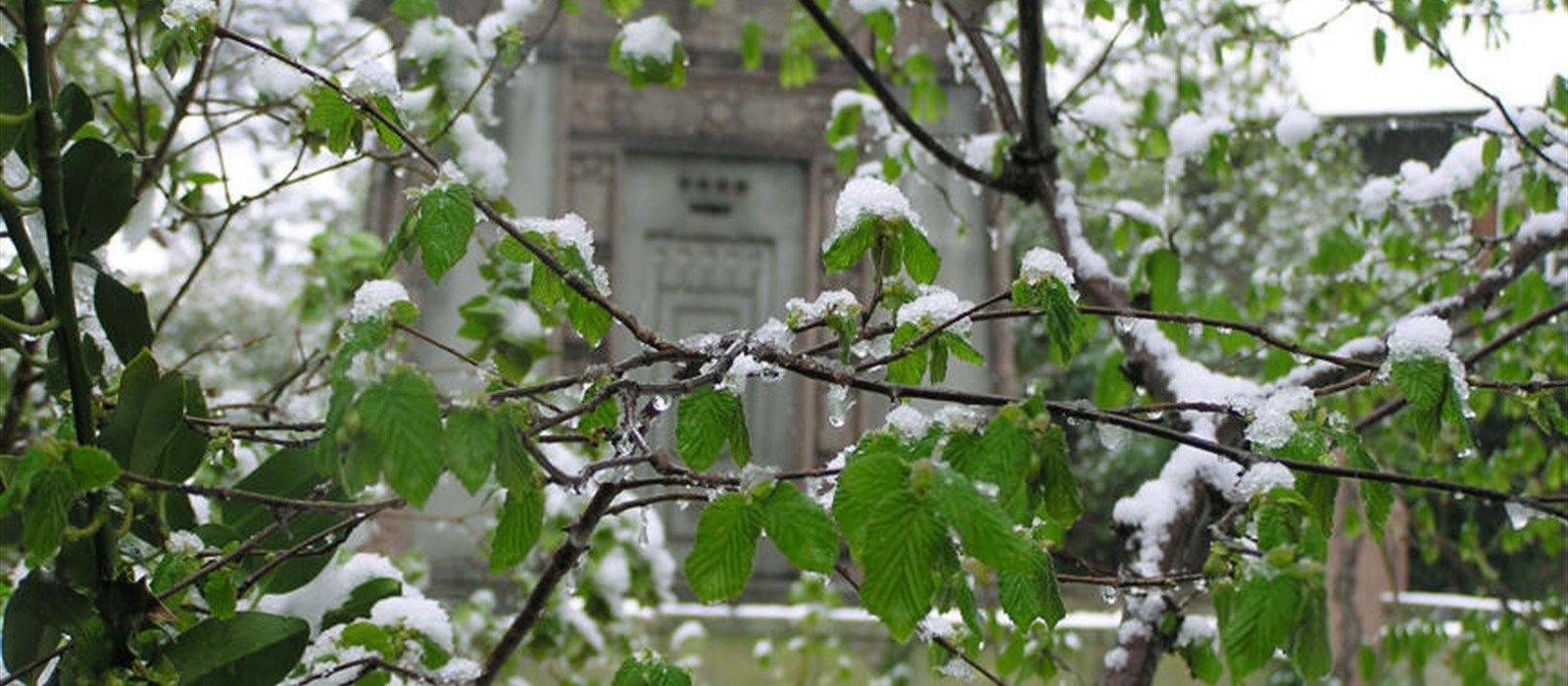
Historic Environment volunteer Anne Logie writes:
Among the buildings which Habitats & Heritage has in its care is the Grade II* listed Kilmorey Mausoleum. Few mausolea can have had quite such a colourful history as the Kilmorey, built in 1854 for Priscilla Anne Hoste, the recently deceased mistress – and former ward – of Francis Jack Needham, 2nd Earl of Kilmorey.
The Egyptian Revival style mausoleum in St Margarets was designed to hold the bodies of Priscilla and Francis in sumptuous style and was erected at great expense in a circular plot in Brompton Cemetery, however poor Priscilla was not allowed to rest in peace, as the Earl took the mausoleum with him when he moved to Woburn Park, Chertsey, in 1862 and then to Gordon House, Twickenham, in 1868. Since Francis’s death in 1880 the land has been developed for housing and the mausoleum is now hidden within a walled enclosure, its grounds managed as a wildlife garden.
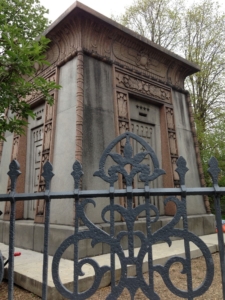
While Kilmorey was having his mausoleum built, the St George’s Hanover Square Burial Board, seeking to relieve the pressure on its existing burial grounds, bought land for an additional cemetery beside the Uxbridge Road in Hanwell, the first interment taking place in 1854. Last year a member of the Environment Trust’s staff was strolling down Hanwell Cemetery’s imposing treelined avenue and noticed a small mausoleum belonging to Alexander Kéller which though not grand certainly showed aspiration and had a door frame strongly echoing that of the Kilmorey Mausoleum. Both incorporate carvings of stars, lotus buds, and the winged sun, all of which are motifs typical of the Egyptian Revival style.

The Egyptian revival style became popular in the early nineteenth century. Following the French invasion of Egypt under Napoleon at the end of the eighteenth century many ordinary Europeans saw for themselves the remarkable ruins of ancient Egypt, or at least the fragments taken from them, and a wave of interest, leading to the founding of the discipline of Egyptology, followed. The wider public would have become familiar with images of temple ruins through the work of artists such as David Roberts (image 3), and unsurprisingly the Egyptian tombs and temples were taken as inspiration for funerary architecture. Abney Park Cemetery in Stoke Newington has a magnificent Egyptian inspired entrance built in 1840 (William Hosking) and Highgate Cemetery has an entire Egyptian Avenue, also dating from the early 1840s.
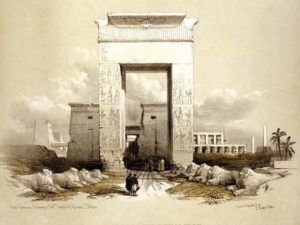
But what of Kéller’s little mausoleum in Hanwell? At first glance it looks very similar to Kilmorey Mausoleum – might it have been inspired by Kilmorey? Was there any connection? And what was Kéller’s connection to all the people buried in the vault below his mausoleum, none named Kéller?
The earliest record I’ve found for Alexander Kéller is the 1861 census, which lists him as a book keeper, aged 27, born in Budapest and lodging with the Field family in Islington. I cannot find any further reference to him until he appears in the 1881 census, described as a 47 year old “Brazilian merchant” lodging at 13 Edith Grove, Fulham, the home of 39 year old Caroline M Dudley, a widowed annuitant sufficiently well off to employ both a cook and a housemaid. Before retiring from the firm in 1886 Kéller was a partner in Pinto Leite and Nephews, merchants, of London, Manchester, and Liverpool, which perhaps traded with Brazil. In the 1891 census Kéller is described as a retired merchant.
Although Edith Grove is very close to Brompton Cemetery, Kilmorey had taken his mausoleum away in 1862, and there is no way of knowing whether either of them saw it before it was moved.
Alexander married Caroline May Pryce (no longer any reference to the name Dudley) early in 1890 and they continued to live at 13 Edith Grove for the rest of their lives, which in Caroline’s case was not very long. She died on 12 March 1895, and her brother, John William Pryce, a former soldier, died in September the same year. Caroline was interred in the mausoleum, and John in the vault below it. Alexander and Caroline had already had two of John’s daughters staying with them, and now Alexander took in John’s widow, Isabel, and those of her children still living at home.
I have not been able to find a date for the erection of the Kéller mausoleum so it is not clear whether he had created it for himself long before marrying Caroline or whether it was built in response to her death. Stylistically it would make more sense for it to have been built some time in the mid nineteenth century, as by 1895 it would surely have seemed somewhat old-fashioned, but on the other hand if it were built in the 1850s for whom, apart from himself, had he intended it, particularly as it has not only the mausoleum chamber but also a vault?
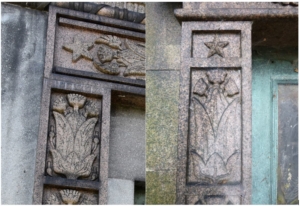
In the 1901 census Alexander is described as a retired banker, and again in 1911, however at some point he acquired land in Sandown on the Isle of Wight and newspaper reports seem to suggest that he was involved in property development in the town. In 1905 he donated land for the building of Sandown’s Andrew Carnegie funded Free Library, and his donation is commemorated on the library’s memorial stone (if the building still stands). Even allowing for the fulsome praise which would be publicly heaped upon such a donor, the speech made at the inaugural ceremony, which Alexander did not attend, is interesting for its characterisation of him. Mr Kéller’s genial presence was frequently seen in Sandown and was a ray of sunshine in the midst. He was always happy and made everyone happy with whom he came in contact. In the houses erected all around them [the people of Sandown] saw the result of his living in Sandown. There were few who would have converted such a curious neighbourhood into a residential one like that. Indeed Mr Kéllor had planned to put a building of his own on the corner site which he had so generously donated for the Library.
In September 1914 it was reported that Mr Kéller had provided one hundred mattresses for the troops quartered in the district and placed an order for one hundred blankets as well.
Alexander died in Edith Grove on 31 May 1920 aged 87. He left an estate worth £83,351 (equivalent to £5.2million today!) and made provision in his will for a payment of £500 to his gardener in the Isle of Wight and a year’s wages to several of his servants. It appears likely that he made ongoing provision for Isobel, who lived until 1928 before joining her husband in the vault below the mausoleum.
Alexander was buried in the mausoleum with Caroline, the words “God’s good man” carved below his name.
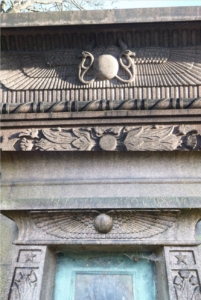
In another small mirroring of the Kilmorey Mausoleum there is a degree of notoriety attached to Alexander’s funeral arrangements. In October 1920 newspapers up and down the country reported under headlines such as “Window In His Coffin” the stipulation in Alexander’s will: “I direct that my body be placed in a lead-covered shell, provided with a face window of plate glass, such shell being placed in a coffin of durable hard wood, and my body so kept for a week before the lid of the outer coffin is screwed down”.
God’s good man, but perhaps not as happy as he appeared.
While there doesn’t appear to be a link to Kilmorey Mausoleum, we’ve loved looking into the history of the Keller Mausoleum in Hanwell. Do let us know your thoughts!
Image 1: Kilmorey Mausoleum
Image 2: Keller Mausoleum
Image 3: The Great Gateway leading to the Temple of Karnak, Nubia by David Roberts
Images 4-7: Details from the two mausolea
Author of this article: Anne Logie, Historic Environment volunteer